Global financial markets are awaiting the decision of the Chinese People’s Bank regarding the reference price of the yuan, amid expectations that Beijing will resort to weakening its currency in response to the customs duties imposed by US President Donald Trump recently on its exports, according to a report published by Bloomberg.
The yuan facing definitions
The Chinese People’s Bank is expected to determine the reference price of the yuan at a weaker level of 7.2 per dollar, according to the estimates of the Australia Group, New Zealand Banking and Malaya Bank, where the first is expected to break this barrier during the current week, in an attempt to counter the negative effects of the US tariffs.
The data indicates that the US dollar has increased significantly since Trump won the elections November/Last November, which led to a decrease in the value of the yuan, which forced the Chinese authorities to intervene repeatedly to maintain the stability of the currency.
Expectations of an additional decline in the yuan
The Goldman Sachs Group expects that the yuan will gradually decrease to the level of 7.3 per dollar. “Modifying the value of the yuan is inevitable, as the currency must play the role of shock absorbers to meet the economic impacts caused by the high customs tariffs,” says Khun Go, head of Asia Research in the Australia and New Zealand banking group.
Go’s weak yuan may have widespread effects on other Asian currencies, and may lead to the exit of capital from emerging markets, putting the region’s assets under additional pressure.
The yuan at the lowest level since 2022
After Trump announced the imposition of customs duties by 10% on Chinese goods last Saturday, the yuan fell by 0.7% to 7.3734, which is its lowest level since October 2022, but he regained part of his losses after Trump indicated that the talks with Beijing indicated that Beijing was with Beijing It is still ongoing, stressing that the definitions may be more severe if an agreement is not reached.
It is reported that Trump had threatened during his election campaign to impose definitions of 60% on Chinese products, but until now he is satisfied with imposing only 10%, which gives Beijing some fields to maneuver, but at the same time it enhances market fears of the outbreak of a comprehensive commercial war.
A gradual reduction or a sharp move?
China is expected to announce the new reference exchange rate tomorrow, Wednesday, with the reopening of the financial markets after the lunar holiday. The Chinese authorities allow the yuan to move by 2% up or down from the reference price set daily.
“In the previous trade war, China allowed the yuan to decline gradually, and we expect the same scenario to happen this time,” said Fiona Lim, chief strategic analyst at Malaya Bank.
While the expectations of the yuan are increasing to weaker levels, some analysts believe that the Chinese People’s Bank will try to control the decline to avoid Trump’s accusations of manipulating the currency.
Markets are in the event of anticipation
The Wall Street Journal confirmed that China will not resort to manipulation of the exchange rate as an attempt to meet the definitions, noting that Beijing may reaffirm its commitment not to use the currency as a competitive tool in global markets.
In the same context, Alfayen Tan, a market analyst at the Canadian RBC Bank, said: “Trump’s definitions of 10% are not completely destroyed, and the Chinese People’s Bank will seek to calm the markets through a gradual reduction and not surprising.”
But even with these efforts, the risks remain, as the Goldman Sachs group expects that the yuan will reach the level of 7.4-7.5 in the coming months if economic pressures continue, which means an additional decline of 3.4% from its last closure at 7.2535.



